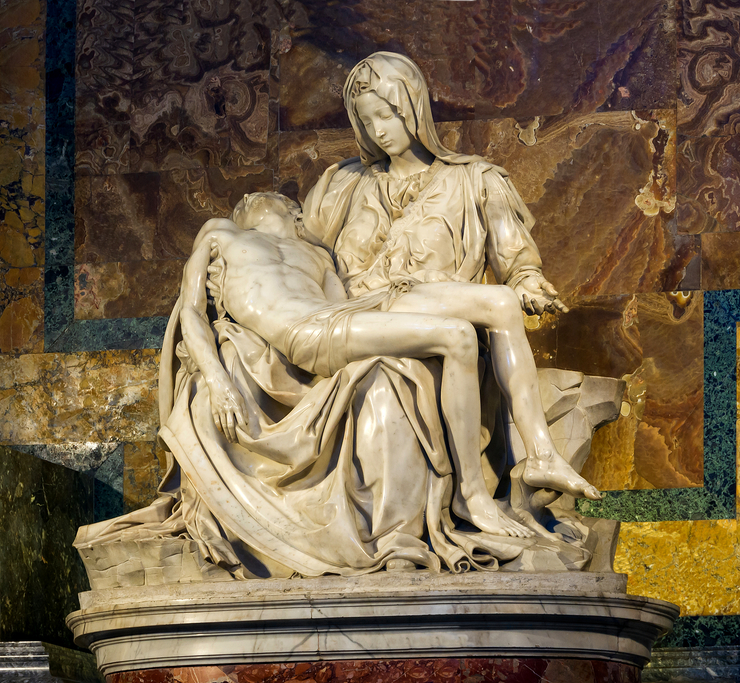Mary as the Mother Who Cries With Us
by Sarah Reinhard | September 14, 2015 12:04 am
 [1]
[1]“Pietà” by Michelangelo located in St. Peter’s Basilica
I didn’t know what to say, and yet words of comfort seemed to come from my lips. We sat there, in the cozy Bob Evans down the street from the hospital, and I tried to keep myself from resorting to joking or bantering.
As my mother-in-law ordered her salad and coffee, I realized I was not at a table in a homey Ohio restaurant, but that I was in a time machine.
Had it already been eight years since I had picked up my mother-in-law from the hospital to take her for a bite to eat after one of the hardest mornings of her life? She had ordered coffee and soup on that October morning, and though her eyes were red, she didn’t really cry. I wanted to sob, though I didn’t really know how. Crying wasn’t my job. I was there to be transportation and lunch provider.
That morning, we had gotten the call that her daughter’s baby had died in utero. Someone had taken her down to the hospital to be there, and I was picking her up to take her home.
Though I wasn’t yet a member of the family by marriage, I felt the pang as though it was my own sister who had lost a baby. I had watched her and her husband make the decision to defy their doctor’s insistence that an abortion was the only solution. I witnessed their courage and their peace as they cherished the only months they would have with Logan alive, while he was in the womb.
And I thought for sure that enough prayer could change the outcome.
It was during those months of waiting and hoping that I learned to pray the rosary. I had just become Catholic, and during our parish’s new Eucharistic Adoration program, I stumbled my way through the unfamiliar rhythm of the prayers. I used my fingers while I commuted and prayed along with a CD I found.
I was certain that Mary would understand. I just knew that she could make it all better.
What I didn’t realize then, in my fervent praying and petitioning, was that suffering isn’t the worst thing that can happen in this life. Sometimes, suffering can bring us great graces, and it can be a line for us to clutch in the midst of our time here on earth.
It wasn’t easy, and it still isn’t easy, to bury a baby. I can’t talk about it, even more than a decade later, without tearing up, and it wasn’t even my baby. But in that well of pain and hurt, there’s something else.
That something else is what Mary offers us in her role as Our Lady of Sorrows. We’re reminded of how innocent she was, conceived as she was without the burden of any sin. How much worse was it for someone who had never sinned and could never sin to bear the brunt of her Son’s passion and death?
The seven sorrows of Mary are a journey I better understand as I stand in the glow of the small white casket of my infant nephew. They begin with the prophecy of Simeon at the Temple, when he promised Mary a sword to pierce her heart. Did she know then what that sword would be? Did the mention of it fill her with dread? Did she hope to avoid it, despite the prophecy?
Soon after Jesus’ birth, when Herod hunts the babies in Bethlehem, Joseph and Mary flee with Jesus to Egypt. It must have been a long, hard journey, and it bears reflection as the second in Mary’s seven sorrows. Was Jesus fussy in the chaos of leaving so suddenly? What important things did Mary forget in the flurry of activity? How long did the trip take?
After the Holy Family returned to Nazareth years later, Mary and Joseph took Jesus to Jerusalem, only to lose Him for three days. I can only imagine the fear in Mary’s heart as they searched for Him. How did she feel when they first found Him?
The last four sorrows all revolve around His passion and death, beginning with Mary’s meeting Jesus as He carried His cross. We then find her at the foot of the cross, beneath her Son. After His death, He’s taken off the cross and handed to Mary. And, finally, He is buried, the last of the sorrows.
At first, these sorrows seem so remote, pictures of a time and place that’s irrelevant to my modern life. But my own journey of sorrows, and especially watching my husband’s family as they buried a baby, I find myself realizing that Mary does, in fact, have something in common with me.
Mary lived in a different time and place. Her experience of daily living was nothing like mine in the details. She didn’t have the convenience of electricity, for one thing. Her vocation was outlined in a very different way.
And yet, I find that the Mother of God and I do share the humanity of suffering. As she stood at the foot of the Cross, she must have felt the full cascade of emotions and the brunt of sorrow. The three days before Jesus rose must have been torture.
It’s easier to lean back into the arms of someone who’s been there. I look to Mary and see the careworn face of a wife, daughter, and mother who has known the burden of everyday life, the small stings and the big burns. I turn to Mary and I feel the comfort of someone who has survived the suffering and offers me the same graces.
All I have to do is accept them.
- [Image]: http://www.integratedcatholiclife.org/wp-content/uploads/michelangelo-pieta-w740.jpg
Source URL: https://integratedcatholiclife.org/2015/09/reinhard-mary-as-the-mother-who-cries-with-us/